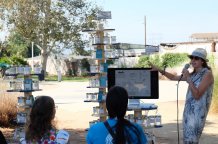
Dr Olivia Osborne is a postdoctoral researcher at the University of California's Center for Environmental Implications of Nanotechnology at UCLA.
Exeter graduate combines her passion for Art and Science - IWD 2017
Dr Olivia Osborne (BSc Biological Sciences, 2009 and PhD Ecotoxicology of Nanomaterials, 2014) swapped the south west countryside for the LA sunshine, where she is now a postdoctoral researcher at the University of California's Center for Environmental Implications of Nanotechnology at UCLA.
In addition to her scientific research, Olivia also pursues her love of art and in 2016 had her work included as part of the ‘CURRENT:LA’ Public Art Biennial.
“My research at UCLA hopes to understand how nanomaterials make their way from the things they were designed for into oceans and rivers, and what they do to fish in those waters. It involves observing how different concentrations of these nanoparticles affect the fish as they go through different life stages.” says Olivia, who’s just received the Chancellors Award Nomination for exceptional accomplishments in research.
“Specifically, I work with the zebrafish - Danio rerio - the small, torpedo-shaped stripy creature you probably know well if you’ve ever owned a fish tank. They are perfect for big-scale scientific observation. The adults lay thousands of embryos daily, which allow us to perform large toxicity screens and these embryos are wrapped in a transparent membrane, so it’s easy to observe any abnormalities that develop. Plus the embryos also grow to larvae in just a few days, so I can collect large amounts of data quickly. We are only just beginning to make full use them of in the adult stage.
“So far, my research has shown that nanoparticle size matters. I published a study in 2015 on the effects of silver nanoparticles, in particular, where I found that the smaller the particles, the more damage they caused to the fish’s gills and gut. And small particles tend to linger, or “bioaccumulate,” in the fish’s system, even when the fish are transferred to cleaner waters. Over time, this bioaccumulation can build up through food chains.”
Olivia’s research was highlighted by the American Chemical Society, who produced a video on the subject, and it was also featured in a silver nanoparticle exhibition at the Science Museum in London in 2016.
For Olivia, art and science are inextricably linked and she uses her background in biological sciences to inspire her other passion – producing artwork.
In early 2015, she was named as one of the top 100 emerging USA artists for the LA category and more recently was the feature artist for the Cybernetics and Human Knowing Journal which highlighted 10 years of her work
In 2016, a Bloomberg public art grant funded an Art|Sci Installation of Olivia’s as part of the ‘CURRENT:LA’ Art Biennial. Her interactive exhibition ‘Water Canning’, consisted of a water molecule structure created from jars in collaboration with the public, and installed in various parks across Los Angeles. Olivia gave presentations to people attending the exhibition, focusing on water conservation and environmental issues.
In addition, artwork of hers, a series of paintings concerning the current drought problem in California entitled ‘Cry me a river California’, was sold at the UNICEF Gala in 2014/15. The artwork was a way of reaching out to non-scientists about environmental stewardship.
“My latest exhibition was ‘Fluid Systems’, a collaboration with fellow Art|Sci Collective members.” says Olivia. “It’s about integrating living systems, the watershed, climate change, and ice, and exploring relationship between flows on the macro and micro level. Current advances in microfluidics – the technologies that allow researchers to simulate and study the interactions of fluids – inspired us to do this show. In manipulating very small volumes of liquid, we can begin to understand complex phenomena from the bottom up.” This exhibition was sparked from the interdisciplinary Sci|Art lectures/workshops Olivia had designed/given over summer for this highly competitive, 2-week summer program for high school juniors and seniors interested in collaborating with diverse and notable minds to challenge traditional, polarized perspectives of the arts and sciences.
“You might think that there is a gulf between the laboratory and the art studio, but that’s not my experience. Both science and art begin with an idea, followed by a process of investigation, and ultimately result in completed work. For me, art sparks my imagination when I’m mapping out experiments and presenting results. And science inspires me to explore new techniques in art. Both give me essential tools for thinking critically and creatively in caring for nature.”
Date: 8 March 2017

